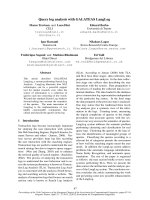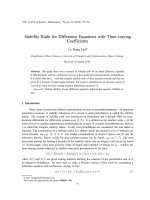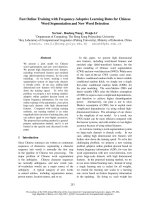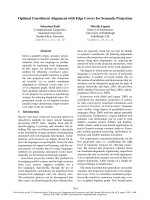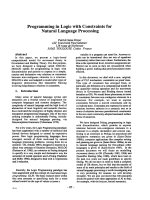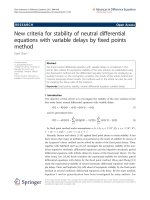Báo cáo " Stability Radii for Difference Equations with Time-varying Coefficients " ppt
Bạn đang xem bản rút gọn của tài liệu. Xem và tải ngay bản đầy đủ của tài liệu tại đây (178.76 KB, 10 trang )
VNU Journal of Science, Mathematics - Physics 26 (2010) 175-184
Stability Radii for Difference Equations with Time-varying
Coefficients
Le Hong Lan*
Department of Basic Sciences, University of Transport and Communication, Hanoi, Vietnam
Received 10 August 2010
Abstract. This paper deals with a formula of stability radii for an linear difference equation
(LDEs for short) with the coefficients varying in time under structured parameter perturbations.
It is shown that the l
p
− real and complex stability radii of these systems coincide and they are
given by a formula of input-output operator. The result is considered as an discrete version of
a previous result for time-varying ordinary differential equations [1].
Keywords: Robust stability, Linear difference equation, Input-output operator, Stability ra-
dius
1. Introduction
Many control systems are subject to perturbations in terms of uncertain parameters. An important
quantitative measure of stability robustness of a system to such perturbations is called the stability
radius. The concept of stability radii was introduced by Hinrichsen and Pritchard 1986 for time-
invariant differential (or difference) systems (see [2, 3]). It is defined as the smallest value ρ of the
norm of real or complex perturbations destabilizing the system. If complex perturbations are allowed,
ρ is called the complex stability radius. If only real perturbations are considered, the real radius is
obtained. The computation of a stability radius is a subject which has attracted a lot of interest over
recent decades, see e.g. [2, 3, 4, 5]. For further considerations in abstract spaces, see [6] and the
references therein. Earlier results for time-varying systems can be found, e.g., in [1, 7]. The most
successful attempt for finding a formula of the stability radius was an elegant result given by Jacob
[1]. In that paper, it has been given by virtue of output-input operator a formula for L
p
− stability for
time-varying system subjected to additive structured perturbations of the form
˙x(t) = B(t)x(t) + E(t)∆(F (·)x(·))(t), t 0, x(0) = x
0
,
where E(t) and F (t) are given scaling matrices defining the structure of the perturbation and ∆ is
an unknown disturbance. We now want to study a discrete version of this work by considering a
difference equation with coefficients varying in time
x(n + 1) = (A
n
+ E
n
∆F
n
)x(n), n ∈ N. (1)
∗
E-mail:
This work was supported by the project B2010 - 04.
175
176 L.H. Lan / VNU Journal of Science, Mathematics - Physics 26 (2010) 175-184
This problem has been studied by F. Wirth [8]. However, in this work, he has just given an estimate
for stability radius. Following the idea in [1], we set up a formula for stability radius in the space l
p
and show that when p = 2 and A, E, F are constant matrix, we obtain the result dealt with in [5]
The technique we use in this paper is somewhat similar to one in [1]. However, in applying the
main idea of Jacob in [1] to the difference equations, we need some improvements. Many steps of the
proofs in the paper [1] are considerably reduced and this reduction is valid not only in discrete case
but also in continuous time one.
An outline of the remainder of the paper is as follows: the next section introduces the concept
of Stability radius for difference equation in l
p
. In Section 3 we prove a formula for computing the
l
p
− stability radius.
2. Stability radius for difference equation
We now establish a formulation for stability radius of the varying in times system
x(n + 1) = B
n
x(n), n ∈ N, n > m
x(m) = x
0
) ∈ R
d
.
(2)
It is easy to see that the equation (2) has a unique solution x(n) = Φ(n, m)x
0
where Φ =
{Φ(n, m)}
nm0
is the Cauchy operator given by Φ(n, m) = B
n−1
···B
m
, n > m and Φ(m, m) =
I. Suppose that the trivial solution of (2) is exponently stable, i.e., there exist positive constants
M and α ∈ (0, 1) such that
Φ(n, m)
K
d×d
Mα
n−m
, n m 0. (3)
We introduce some notations which are usually used later. Let X, Y be two Banach spaces
and N be the set of all nonegative integer numbers. Put
• l(0, ∞; X) = {u : N → X}.
• l
p
(0, ∞; X) = {u ∈ l(0, ∞; X) :
∞
n=0
u(n)
p
< ∞} endowed with the norm u
l
p
(0,∞;X)
=
(
∞
n=0
u(n)
p
)
1/p
< ∞.
• l
p
(s, t; X) = {u ∈ l
p
(0, ∞; X) : u(n) = 0 if n /∈ [s, t]}.
• L(l
p
(0, ∞; X), l
p
(0, ∞; Y )) is the Banach space of all linear continuous operators from
l
p
(0, ∞; X) to l
p
(0, ∞; Y ).
Sometime, for the convenience of the formulation, we identify l
p
(s, t; X) with the space of all
sequences (u(n))
t
n=s
.
The truncated operators of l(0, ∞; X) are defined by
π
t
(x(·))(k) =
x(k), 0 k t,
0, k > t,
and
[x(· )]
s
(k) =
0, 0 k < s,
x(k), k s.
An operator Γ ∈ L(l
p
(0, ∞; X), l
p
(0, ∞; Y )) is said to be causal if π
t
Aπ
t
= π
t
A for any t > 0
(see [1]).
L.H. Lan / VNU Journal of Science, Mathematics - Physics 26 (2010) 175-184 177
Let A ∈ L(l
p
(0, ∞; K
q
), l
p
(0, ∞; K
s
)) be a causal operator. We consider the system (2)
subjected to perturbation of the form
x(n + 1) = B
n
x(n) + E
n
A(F
.
x(·))(n), n ∈ N, (4)
where E
n
∈ K
d×s
; F
n
∈ K
q×d
; the operator A is a perturbation.
A sequence (y(n)) ∈ l(0, ∞; K
d
) is called a solution of (4) with the initial value y(n
0
) = x
0
if
y(n + 1) = B
n
y(n) + E
n
A([F
.
y(·)]
n
0
)(n), n n
0
. (5)
Suppose that (y(n)) is a solution of (4) with the initial value y(n
0
) = x
0
. It is obvious
that for n > m > n
0
the following constant-variation formula holds
y(n) = Φ(n, m)y(m) +
n−1
m
Φ(n, k + 1)E
k
A([π
m−1
(F
.
y(·))]
n
0
)(k) + E
n
A(π
m−1
[F
.
y(·)]
n
0
)(n)
+
n−1
m
Φ(n, k + 1)E
k
A([F
.
y(·)]
m
)(k) + E
n
A([F
.
y(·)]
m
)(n). (6)
We are now in position to give a formula for stability radii for difference equation. Now
let the unique solution to the initial value problem for (4) with initial value condition x(n
0
) = x
0
denote by x(· ; n
0
, x
0
). In the following, we suppose that
Hypothese 2.1. E
n
; F
n
; are bounded on N.
We define the following operators
(L
0
u)(n) = F
n
n−1
k=0
Φ(n, k + 1)E
k
u(k)),
(
L
0
u)(n) =
n−1
k=0
Φ(n, k + 1)E
k
u(k),
for all u ∈ l
p
(0, ∞; K
s
), n > 0. The first operator is called the input-output operator associated
with (2). Put
(L
n
0
u)(n) = (L
0
[u]
n
0
)(n), (
L
n
0
u)(n) = (
L
0
[u]
n
0
)(n).
(7)
We see that these operators are independent of the choice of T
n
. It is easy to verify the
following auxiliary results.
Lemma 2.2. Let (3) and Hypothesis hold. The following properties are true
a) L
n
0
, ∈ L(l
p
(n
0
, ∞; K
s
), l
p
(n
0
, ∞; K
q
));
L
n
0
∈ L(l
p
(n
0
, ∞; K
s
), l
p
(n
0
, ∞; K
d
)),
b) L
t
L
t
, t t
0,
c) There exist constants M
1
0 such that
Φ(·, n
0
)x
0
l
p
(n
0
,∞;K
d
)
M
1
x
0
K
d
, n
0
0, x
0
∈ K
d
.
With these operators, any solution x(n) having the initial condition x(n
0
) = x
0
) of (4)
can be rewritten under the form
x(n) = Φ(n, n
0
)x
0
+
L
n
0
A([F
.
x(·)]
n
0
)(n), n > n
0
.
(8)
Definition 2.3. The trivial solution of (4) is said to be globally l
p
−stable if there exist a constant
M
2
> 0 such that
x(·; n
0
, x
0
)
l
p
(n
0
,∞;K
d
)
M
2
x
0
K
d
,
(9)
for all x
0
∈ K
d
.
178 L.H. Lan / VNU Journal of Science, Mathematics - Physics 26 (2010) 175-184
Remark 2.4. From the inequality
x(n; n
0
, x
0
)
K
d
x(·; n
0
, x
0
)
l
p
(n
0
,∞;K
d
)
for any n n
0
, it follows that that the global l
p
-stability property implies the K
d
− stability in initial
condition.
In comparing with [1, Definition 3.4], in the discrete case, we use only the relation (9) to
define l
p
−stability.
3. A formula of the stability radius
First, the notion of the stability radius introduced in [1, 2, 9] is extended to time-varying
difference system (2).
Definition 3.1. The complex (real) structured stability radius of (2) subjected to linear, dynamic
and causal perturbation in (4) is defined by
r
K
(A; B, E, F ) = inf {A : the trivial solution of (4) is not globally l
p
−stable },
where K = C, R, respectively.
Proposition 3.2. If A ∈ L(l
p
(0, ∞; K
q
), l
p
(0, ∞; K
s
)) is causal and satisfies
A < sup
n
0
0
L
n
0
−1
,
then the trivial solution of the system (4) is globally l
p
− stable.
Proof. Let m n
0
be arbitrarily given. It is easy to see that there exists an M
3
> 0 such that
x(n; n
0
, x
0
)
K
d
M
3
x
0
∀ n
0
n m. (10)
Therefore,
x(·, n
0
, x
0
)
l
p
(n
0
,m,K
d
)
(m −n
0
)M
3
x
0
. (11)
Now fix a number m > n
0
such that AL
m
< 1. Due to the assumption on A, such an m
exists. It follows from (6) that
x(n, n
0
, x
0
) = Φ(n, m)x(m, n
0
, x
0
) +
n−1
k=m
Φ(n, k + 1)E
k
A([π
m−1
(F
.
x(·, n
0
, x
0
))]
n
0
)(k)
+
n−1
k=m
E
k
A([F
.
x(·, n
0
, x
0
)]
m
)(k)
for n m. Therefore,
F
n
x(n; n
0
, x
0
) = F
n
Φ(n, m)x(m; n
0
, x
0
) + (L
m
(A(π
m−1
[F x]
n
0
)))(n) + (L
m
(A([F x]
m
)))(n).
(12)
From (10) and (12) we have
F
.
x(·; n
0
, x
0
)
l
p
(m,∞,K
q
)
F
.
Φ(·, m)x(m ; n
0
, x
0
)
l
p
(m,∞,K
q
)
+ (L
m
(A(π
m−1
[F x]
n
0
)))(·)
l
p
(m,∞,K
q
)
+ (L
m
(A([F x]
m
)))(·)
l
p
(m,∞,K
q
)
M
1
F
.
x(m; n
0
, x
0
)
K
d
+ L
m
A(π
m−1
[F x]
n
0
)(·)
l
p
(n
0
,m,K
q
)
+ L
m
A[Fx]
m
)(·)
l
p
(m,∞,K
q
)
.
L.H. Lan / VNU Journal of Science, Mathematics - Physics 26 (2010) 175-184 179
Therefore,
(1 −L
m
A) F
.
x(·; n
0
, x
0
)
l
p
(m,∞,K
q
)
F
.
M
1
M
3
+ M
4
L
m
A
x
0
which implies that
F
.
x(·; n
0
, x
0
)
l
p
(m,∞,K
q
)
(1 −L
m
A)
−1
F
.
M
1
M
3
+ M
4
L
m
A
x
0
. (13)
Setting M
5
:= (1 −L
m
A)
−1
F
.
M
1
M
3
+ M
4
L
m
A
we obtain
F
.
x(·; n
0
, x
0
)
l
p
(m,∞,K
q
)
M
5
x
0
K
d
.
Hence, using (11) we have
F
.
x(·; n
0
, x
0
)
l
p
(n
0
,∞,K
q
)
M
6
x
0
K
d
,
where M
6
= M
4
+ M
5
. Further, by (8)
x(·; n
0
, x
0
)
l
p
(n
0
,∞,K
d
)
Φ(·, n
0
)P
n
0
−1
x
0
l
p
(n
0
,∞,K
d
)
+
L
n
0
AF
.
x(·, n
0
, x
0
))
l
p
(n
0
,∞,K
q
)
M
1
P
n
0
−1
x
0
+
L
n
0
AF
.
x(·, n
0
, x
0
))
l
p
(n
0
,∞,K
q
)
M
7
P
n
0
−1
x
0
,
where M
7
= M
1
+
L
n
0
AM
6
. The proof is complete.
Thus, by Proposition 4.3, the inequality
r
K
(A; B, E, F ) sup
n
0
0
L
n
0
−1
holds. We prove the converse relation.
We note that L
n
is decreasing in n. Therefore, there exists the limit
lim
n
0
→∞
L
n
0
l
p
(0,∞;K
q
)
=:
1
β
.
Proposition 3.3. For every δ, β < δ < L
0
−1
there exists a causal operator A ∈ L(l
p
(0, ∞;
K
q
), l
p
(0, ∞; K
s
)) with A < δ such that the trivial solution of (4) is not globally l
p
− stable.
Proof. Let us fix the numbers ε > 0, γ > β satisfying 0 < γ(1−εγ)
−1
< A. Since L
n
l
p
(0,∞;K
q
)
↓
1
β
>
1
γ
,
L
n
l
p
(0,∞;K
q
)
>
1
γ
, ∀n 0.
In particular, L
0
>
1
γ
. Therefore, we can choose a function
f
0
∈ l
p
(0, ∞; K
s
) with
f
0
l
p
(0,∞;K
s
)
=
1 such that
L
0
f
0
l
p
(0,∞;K
q
)
>
1
γ
.
From the properties
lim
n→∞
π
n
f
0
l
p
(0,∞;K
s
)
= 1, lim
n→∞
L
0
π
n
f
0
l
p
(0,∞;K
q
)
= L
0
f
0
>
1
γ
,
it follows that there exists an m
0
∈ N satisfying
1
π
m
0
f
0
L
0
(π
m
0
f
0
)
l
p
(0,∞;K
q
)
>
1
γ
.
Denoting f
0
=
1
π
m
0
e
f
0
π
m
0
f
0
we obtain
f
0
l
p
(0,∞;K
s
)
= 1, support f
0
⊆ [0, m
0
] and L
0
f
0
l
p
(0,∞;K
q
)
>
1
γ
.
180 L.H. Lan / VNU Journal of Science, Mathematics - Physics 26 (2010) 175-184
Further, for any n > m
0
we have
L
0
(π
m
0
h)(n) = F
n
m
0
k=0
Φ(n, k + 1)E
k
(π
m
0
h)(k)
= F
n
Φ(n, m
0
+ 1)
m
0
k=0
Φ(m
0
+ 1, k + 1)E
k
(π
m
0
h)(k).
Therefore, by virtue of (3), there exists n
0
> m
0
such that
L
0
(π
m
0
h)
l
p
(n
0
,∞;K
q
)
ε
2
h
l
p
(0,∞;K
s
)
. (14)
Similarly, we can find n
0
< m
1
< n
1
and f
1
satisfying
f
1
= 1, support f
1
⊆ [n
0
+ 1, m
1
]
and
L
0
f
1
l
p
(n
0
+1,n
1
;K
q
)
>
1
γ
, L
0
(π
m
1
h)
l
p
(n
1
,∞;K
q
)
ε
2
2
h
l
p
(0,∞;K
s
)
.
Continuing this way, we can find the sequences (f
k
) and n
k
↑ ∞, n
k−1
< m
k
< n
k
having the
following properties
f
k
l
p
(0,∞;K
s
)
= 1, support f
k
⊆ [n
k−1
+ 1, m
k
],
(with n
−1
= −1, m
−1
= −1) and
L
0
f
k
l
p
(n
k−1
+1,n
k
;K
q
)
>
1
γ
, L
0
(π
m
k
h)
l
p
(n
k
,∞;K
q
)
ε
2
k
h
l
p
(0,∞;K
s
)
. (15)
Denote
Qh =
∞
k=0
1
[n
k−1
+1,n
k
]
L
0
([h]
m
k−1
+1
),
where 1
C
denotes the indicator function of the set C. Let f =
∞
k=0
f
k
. By (15) we see that
L
0
f ∈ l
p
(0, ∞; K
q
). Further,
• support Qf
k
⊂ [n
k−1
+ 1, n
k
],
• (L
0
−Q)h
l
p
(0,∞;K
q
)
∞
k=1
L
0
(π
m
k−1
h)
l
p
(n
k−1
,∞;K
q
)
∞
k=1
ε
2
k
h
l
p
(0,∞;K
s
)
= εh
l
p
(0,∞;K
s
)
,
i.e.,
L
0
− Q
l
p
(0,∞;K
q
)
ε. (16)
By Hahn-Banach theorem, for any k ∈ N , there exists a linear functional, namely x
∗
k
, defined
on l
p
(n
k−1
+ 1, n
k
, K
q
) such that
x
∗
k
= 1 and x
∗
k
L
0
f
k
n
k
n
k−1
+1
= L
0
f
k
l
p
(n
k−1
+1,n
k
;K
q
)
.
We define a sequence of causal operators A
k
∈ L(l
p
(0, ∞; K
q
), l
p
(0, ∞; K
s
)) by
A
k
h =
f
k+1
L
0
f
k
l
p
(n
k−1
+1,n
k
;K
q
)
· x
∗
k
(h
n
k
n
k−1
+1
).
The sequence (A
k
) has the following properties
• A
k
(L
0
f
k
) = A
k
(Qf
k
) = f
k+1
,
• A
k
γ.
L.H. Lan / VNU Journal of Science, Mathematics - Physics 26 (2010) 175-184 181
Let
¯
Ah =
∞
k=0
A
k
h.
It is obvious
¯
A = sup{A
k
: k ∈ N}.
Therefore, the operator (I −(Q −L
0
)
¯
A) is invertible and (I −(Q −L
0
)
¯
A)
−1
(1 −εγ)
−1
. Set
A =
¯
A(I − (Q − L
0
)
¯
A)
−1
,
z = (I −(Q −L
0
)
¯
A)Qf.
We see that
A =
¯
A
k
(I − (Q − L
0
)
¯
A)
−1
γ(1 −εγ)
−1
δ,
and
(I − L
0
∆)z =
I −(Q − L
0
)
¯
A)Qf − L
0
¯
AQf = Q(f −
¯
AQf
= Q
f −
∞
k=0
∆
k
∞
i=0
1
[n
i−1
+1,n
i
]
L
0
([f]
m
i−1
+1
)
= Qf
0
= 1
[0,n
0
]
L
0
(f
0
) =: g.
Hence,
(I − L
0
∆)z = g, (17)
which implies that
(I −
L
0
∆F )y =
LAg, (18)
where y =
LAz. From (18) we have F
n
y(n) = z(n) for any n n
0
. Therefore, y ∈ l
p
(0, ∞; K
q
)
because z ∈ l
p
(0, ∞; K
q
) and F is bounded. Moreover, the relation (18) says that y(·) is a
solution of the system
y(n + 1) = B
n
y(n) + E
n
(∆(F
.
y(·)))(n) + E
n
(Ag)(n), (19)
with the initial condition y(0) = 0. Put
h(n) := E
n
(Ag)(n).
It is easy to see that h(n) has a compact support. Substituting into the first one we obtain
y(n + 1) = B
n
y(n) + E
n
A(F
.
)y(·))(n) + h(n). (20)
For any m 0, the equation
x(n + 1) = B
n
x(n) + E
n
(∆(F
.
x(·)))(n), (21)
has a uniquely solution, say x(·, m, x
0
), with the initial condition x(m; m, x
0
) = x
0
. We show
that the sequence (y(n)) defined by
y(n + 1) =
n
k=0
x(n + 1, k + 1, h(k)), y(0) = 0. (22)
182 L.H. Lan / VNU Journal of Science, Mathematics - Physics 26 (2010) 175-184
is a solution of (20) with y(0) = 0. Indeed,
y(n + 1) =
n
k=0
x(n + 1, k + 1, h(k)) =
n−1
k=0
x(n + 1, k + 1, h(k)) + h(n)
=
n−1
k=0
B
n
x(n, k + 1, h(k)) +
n−1
k=0
E
n
A(F
.
x(·, k + 1, h(k)))(n) + h(n)
= B
n
y(n, k + 1, h(k)) + E
n
A(F
.
n−1
k=0
x(·, k + 1, h(k)))(n) + h(n)
= B
n
y(n, k + 1, h(k)) + E
n
A(F
.
·−1
k=0
x(·, k + 1, h(k)))(n) + h(n).
Therefore,
y(n + 1) = B
n
P
n−1
y(n, k + 1, h(k)) + E
n
A((F
.
y(·))))(n) + h(n),
i.e., we get (20).
If (21) is globally l
p
− stable, it follows that
y(·)
l
p
(0,∞;K
d
)
=
∞
n=0
n
k=0
x(n, k + 1, h(k))
p
1/p
∞
n=0
n
k=0
x(n; k + 1, , h(k))
p
1/p
∞
k=0
∞
n=k+1
x(n; k + 1, h(k))
p
1/p
(using Minkowski’s inequality)
M
10
∞
k=0
h(k) < +∞.
Hence, it follows that
y(·)
l
p
(0,∞;K
d
)
< ∞.
That contradicts to y(·) ∈ l
p
(0, ∞; K
d
). This means that (4) is not globally stable.
Summing up we obtain.
Theorem 3.4. For l
p
−stability, the complex stability radius and real stability radius are equal and it
is given by
r
C
(E, A; B, C) = r
R
(E, A; B, C) = sup
n
0
0
L
n
0
−1
.
Corollary 3.5. Let B, E, F be constant matrices and p = 2. Then, there holds
r
C
= r
R
=
sup
|t|1
F (tI −B)
−1
E
−1
.
L.H. Lan / VNU Journal of Science, Mathematics - Physics 26 (2010) 175-184 183
Proof. Since B, E, F are constant matrices, we have
(L
0
u) (n) = F
n−1
k=0
Φ (n, k + 1) Eu
k
= F
n−1
k=0
k+1
m=n
B
Eu
k
F
n−1
k=0
B
n−k−1
Eu
k
.
Denote by H(h) the Fourier transformation of the function h. We see that
H (L
0
u) =
∞
n=0
F
n−1
k=0
B
n−k−1
Eu
k
e
−inω
=
∞
n=0
F
n−1
k=0
B
n−k−1
Eu
k
e
−inω
=
∞
k=0
F
∞
n=k
B
n−k
e
−i(n−k)ω
Eu
k
e
−ikω
=
∞
k=0
F
e
iω
I −B
−1
Eu
k
e
−ikω
= F
e
iω
I −B
−1
E
∞
k=0
u
k
e
−ikω
= F
e
iω
I −B
−1
EH (u)
=
F
e
iω
I −B
−1
E
H (u) = F
e
iω
I −B
−1
EH (u) .
Therefore,
H (L
0
u) = F
e
iω
I −B
−1
EH (u) .
Using Parseval equality we have
H (h) = h
for any h ∈ l
2
(0, ∞; K
q
). Hence,
L
0
u = H (L
0
u) =
F
e
iω
I −B
−1
E.H (u)
.
Thus,
L
0
= sup
u1
F
e
iω
I −B
−1
E.H (u)
= sup
H(u)1
F
e
iω
I −B
−1
E.H (u)
= sup
ω
F
e
iω
I −B
−1
E
.
Or
L
0
= sup
|t|=1
F (tI − B)
−1
E
.
Since lim
t→∞
F (tA − B)
−1
E = 0,
r
C
= r
R
=
sup
|t|1
F (tA − B)
−1
E
−1
.
The proof is complete.
Example 3.6. Calculate the stability radius of the unstructured system
X
n+1
=
−2 1
1 −1
X
n
∀n 0. (23)
The matrix
−2 1
1 −1
has two eigenvalues λ
1
= 1/3 and λ
2
= 2/3 which line in the unit ball.
Therefore, the system (23) is asymptotically stable. Further
(tI −B )
−1
=
9t−2
9t
2
−9t+2
−
2
9t
2
−9t+2
−
2
9t
2
−9t+2
9t−7
9t
2
−9t+2
184 L.H. Lan / VNU Journal of Science, Mathematics - Physics 26 (2010) 175-184
We know that (tI −B)
−1
is the largest eigenvalue of (tI − B)
−1
(tI −B)
−1
which is
−162t + 162t
2
+ 61 + 5
√
324t
2
−324t + 97
2(81t
4
−162t
3
+ 117t
2
−36t + 4)
.
Hence,
sup
|t|=1
(tI − B)
−1
= sup
|t|=1
−162t + 162t
2
+ 61 + 5
√
324t
2
−324t + 97
2(81t
4
− 162t
3
+ 117t
2
−36t + 4)
=
61
8
+
5
8
√
97.
Thus,
r
C
= r
R
=
61
8
+
5
8
√
97
−1
.
References
[1] B. Jacob, A formula for the stability radius of time-varying systems, J. D ifferential Equations, 142(1998) 167.
[2] D. Hinrichsen, A.J. Pritchard, Stability radii of linear systems, Sys tems Control Letters, 7(1986) 1.
[3] D. Hinrichsen, A.J. Pritchard, Stability for structured perturbations and the algebraic Riccati equation, Systems Control
Letters, 8(1986) 105.
[4] D. Hinrichsen, A.J. Pritchard, On the robustness of stable discrete-time linear systems, in New Trends in Systems
Theory, G. Conte et al. (Eds), Vol. 7 Progress in System an d Cont rol Theory , Birkh
•
auser, Basel, 1991, 393.
[5] D. Hinrichsen, N.K. Son, Stability radii of linear discrete-time systems and symplectic pencils, Int. J. Robust Nonlinear
Control , 1 (1991) 79.
[6] A. Fischer, J.M.A.M. van Neerven, Robust stability of C
0
−semigroups and an application to stability of delay equations,
J. Math. Analysis Appl., 226(1998) 82.
[7] D. Hinrichsen, A. Ilchmann, A.J. Pritchard, Robustness of stability of time-varying linear systems, J. Differential
Equations, 82(1989) 219.
[8] F. Wirth, On the calculation of time-varying stability radii, Int. J. Robust Nonlin ear Control, 8(1998) 1043.
[9] L. Qiu, E.J. Davison, The stability robustness of generalized eigenvalues, IEEE Transactions on Automatic Control,
37(1992) 886.


